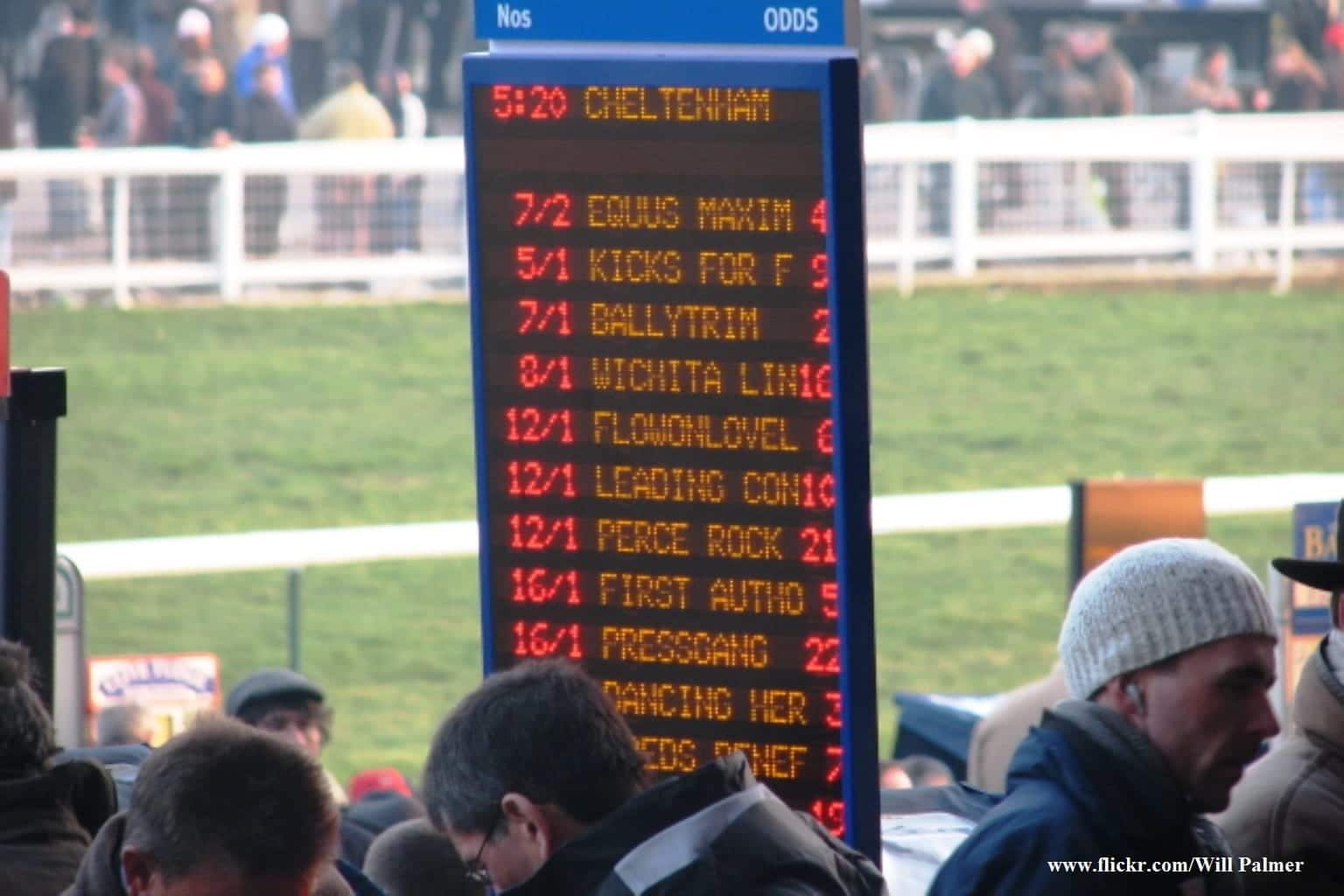How to Create A Lay Betting System
Are you ready to create a laying system? I remember when the betting exchanges, most notably Betfair, took off and it was not long before the schemers and scammers were flooding the online betting product markets with laying systems. With the exchanges being a relatively novel idea, these products sold well with people being sucked in by the hype and the blatantly obvious statement that picking losers was easier than picking winners. Whilst this is true, making a profit from laying horses is not easy.
Some of the laying systems back in the day were very simplistic.
2nd Favourites Laying System
Laying the 2nd favourite in horse racing is an idea that has appealed to a lot of punters and laying all the 2nd favourites is close to a break even propspect.
There were variations of this system and of course you had to bet close to the off to know who the real 2nd favourite was and you had the choice between the on course second fav and the Betfair second favourite.
The table below shows the result of laying all second favourites in flat turf races, as per the Betfair market since 2008, you can see from the column highlighted in yellow that overall a small loss would have been made -0.13% ROI.
Some years have been winning and some losing, but the overall small loss suggests that some rules to reduce the bets may well make it a profitable endeavour.
As you will see below, laying 2nd favourites is a much better prospect than laying favourites.
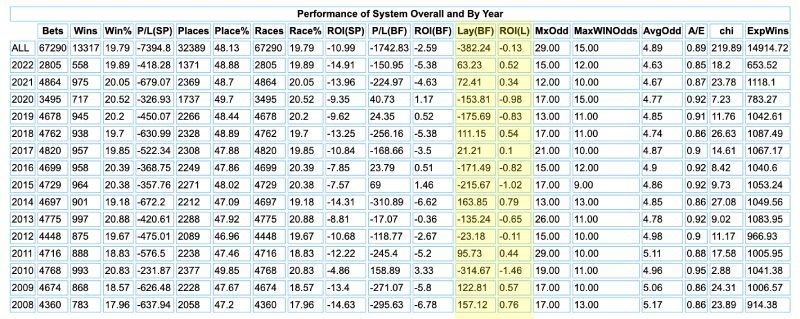
3rd Favourites Laying System
It is generally considered that the betting market is more efficient towards the head of the market, so we would expect a third favourites laying system to perform similarly to 2nd favourites.
Looking at the data below it would appear that is exactly the case with only 0.01% ROI difference between the two.
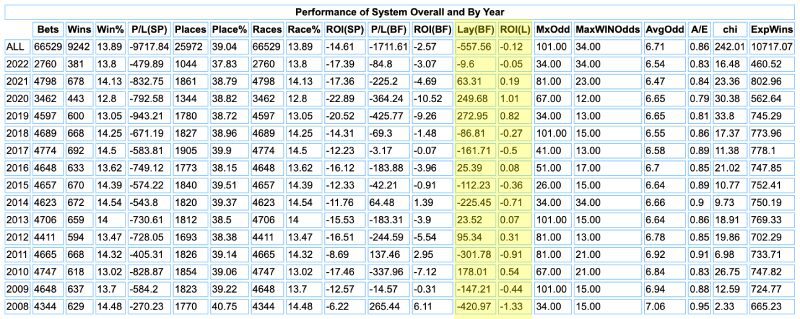
Laying Favourites System
Laying all favourites is not a profitable endeavour, work can be done to identify false favourites, IE those that are priced at less than their true chance, and laying those would be profitable but the stats tell us that 2nd and 3rd favourites are a better prospect for the layer.
The chart below shows the result of betting all favourites in UK flat racing (turf) since 2008.
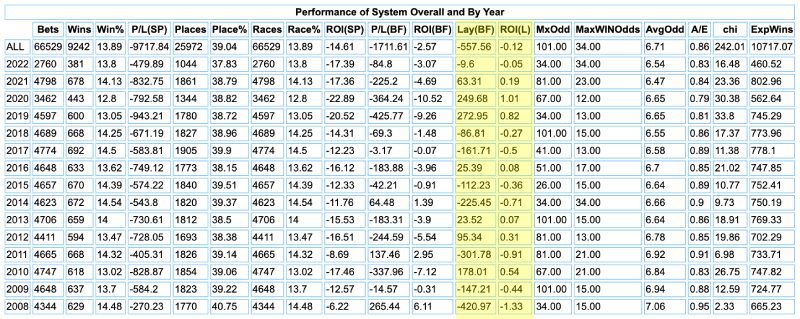
I read a lot of the sales pages and they were chock full of examples of picking one or two losers a day to rack up the profits and enjoy the champagne lifestyle. What they failed to inform the prospective customers was that their liabilities would always be high and that just one or two losing bets would wipe out all the profit banked. Most, if not all, of these products were naff. However, there is certainly plenty of mileage in exploring laying horses as a potentially profitable betting strategy.
In this article I am going to run through the steps in creating a laying system based on statistical data.
If anything, it highlights the opportunities to lay short priced, poor value horses without creating big liabilities. The lowest liability method is to lay favourites, which is kind of obvious as, by virtue of being favourite, they are the shortest price runner in the field. You can limit your liability further by laying only those favourites that go off under a set price, for example, 7/2 which is the decimal price 4.50 on the exchanges.
In the following example I am going to revisit a laying system I created if I remember correctly, back in 2010.
The theory behind it was that favourites in bumper races are often the poorest priced favourite on the card. One of the possible reasons for this is that the bumper races are usually the last race on the card and punters often lump on the favourite to recoup losses from earlier in the day. Another possible reason is that punters often just lump on the favourite because it is running out of one of the top yards such as Paul Nicholls or Nicky Henderson.
To illustrate this fact, I have looked at the performance of favourites sent off at a Betfair SP of 4.50 or shorter in hurdles, chase and bumper races to compare the relative performance and profit and loss (P/L). These are outright favourites and, so we ignore co-favourites and joint-favourites as we only want to be laying one horse in any race. As always, I am using HorseRaceBase (HRB) which has data to Betfair SP for these races going back to 2008.

Taking all outright favourites sent off at 4.50 or shorter in hurdles, chase and bumper races we see that they have a combined strike rate of 40%. So, 40% win and 60% lose.
Next, we can break those races down by national hunt race type:

As you can see, the strike rate is consistent across all three race types.
However, look at the column for (Lay BF). This indicates the profit and loss if you had layed each favourite in the respective race types. Notice how the chase and hurdle favourites would have seen you mount up huge losses by laying them on the exchanges, but laying the bumper favourites would have seen you in profit to the tune of £130.90.
Before we get carried away with those numbers, look at the column next it, ROI (L), which is the return on investment from laying these bumper runners. It is a paltry 1.85%.
That means for every £100 of lay bets you win £1.85. You could probably get a better return in a high interest savings account.
However, the results are strikingly different between those jumping obstacles and those on the flat. One set makes a huge loss and the other makes a profit. It was those results that led me to believe there may be some mileage in laying bumper favourites.
The next thing to do is to break down the bumper runners by price to see if there is any price band we can concentrate on, or others where you just simply cannot make a profit:

As you can see, anything sent off at 1.50 or shorter is probably not worth the effort as we are looking at strike rates of 90% for those sent off 1.25 or shorter and 72% for those sent off at 1.26 to 1.50. For the record these are not worth backing either. I would be inclined to give the ones sent off at 1.51 to 1.75 a swerve too as they only realise a tiny profit and have a strike rate of near 60%. Those sent off at odds of 1.76 or bigger show a positive return for lay bets and we should concentrate on those.
Their combined record is shown in the table below and now we are dealing with a set of runners with a 35% strike rate which is more manageable from a lying perspective seeing as this means that 65% lose their races.

Bumper races tend to be run over 2 miles, but some are run over slightly further whilst others are run over shorter. In addition, some are run on the all-weather (AW) and all bumper cards are increasingly common these days on artificial surfaces. So, next we can look at race distance and racing surface to see if there are any more clues as to what specific conditions we should be targeting.
Having run through the race distances there are no emerging patterns, so we need not worry about race distance as a factor. The AW bumper favourites are 42-126 for a profit of £5.49 when laying so we will keep them in for now.
The next thing I usually do when researching systems is to look at the yearly numbers. Time and time again I see people selling systems based on overall performance without giving you a yearly breakdown. No surprise then that a lot of them do not work as the results are often biased by one or two standout years from the past.
Below is the year by year breakdown of our runners which are outright bumper favourites sent off at odds between 1.76 and 4.5 on the exchanges.

Eight out of the ten years since 2008, these runners would have made a profit it you had layed them on the exchanges. What is encouraging is the last two years have seen 83.24 points profit from the overall 10-year profit of 128.94 points. Note, however, that the return on investment is still low at less than 2% so we still have some work to do as far as creating any sort of worthwhile system.
The next thing I want to do is look at a few other factors such as race Class, Graded and Listed races and how many runs the favourite has had and where they finished on their previous start.
For the number of runs we need to make sure that it is the number of previous runs in bumpers rather than the number of career runs as this would otherwise exclude those runners recruited from the flat ranks.
The results are interesting to say the least.
Graded and Listed bumper favourites tend to underperform. For example, favourites in Grade 2 bumpers sent off at odds of 1.76 to 4.50 are just 2-13, those in Grade 1 races are 3-9 and Listed favourites are 16-56. You would have made £14.64 laying those for £1 each. It is not a huge sample size, but it serves to illustrate the fact that these runners are very poor value from a backing perspective.
Race class is also interesting:

As you can see most of the bumpers are Class 5 and Class 6 and this is where most of the laying profit lies. However, this is simply down to the sheer weight of numbers and the ROI is still small, so I would say race class has no real bearing on the potential outcome.
Next, the number of days since a horse ran shows that those returning to the track quickly (under 11 days) have a good record in terms of backing them to win. The sample size is again small, and the overall record of these runners is 22-58. Around 6 points of losses would have been made laying these runners, so they could be kept out of the equation, but I think we can keep them in for now as I do not want to start back fitting the results.
That brings us nicely to the most striking results and those are seen when we look at the number of previous runs these favourites have had in bumper races. Bumper debutants are 478-1359 (35% strike rate) and no money is to be made laying them on the exchanges. The results are shown in the table below:

What is striking is that the bumper favourites with one run under their belts in this code show a massive level stakes loss if you had backed them and a healthy level stakes profit if you had layed them on the exchanges. The other runners with between 2 and 6 bumper runs combine for an overall loss for the layers.
At this point I am happy to add the number of runs = 1 to the system criteria along with the price bracket we identified earlier. The reason for this is that the ROI for laying these runners is now 9% which is not bad in betting terms and certainly a whole lot better than the 1.85% which can be made by laying all bumper favourites at odds of 4.5 or below.
We now have something to work with and we have a solid, yet simple, set of criteria.
We are looking to lay bumper favourites with exactly one previous run in a bumper that are sent off at odds of 1.76 to 4.50. The overall record of these runners is shown below:

So, we are dealing with a set of runners that win 30% of their races and lose 70% of their races and laying them all to £1, giving a maximum liability against any one horse of £3.50.
Here is a yearly breakdown:
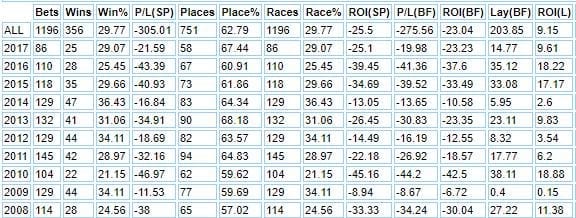
The table above illustrates that this has a lot of promise as all years from 2008 to 2017 show a profit in the Lay (BF) column. Basically, this tells me that year in year out these favourites offer poor value to the backer and plenty of promise for the layer. The ROI is variable from year to year with a low of 0.15% in 2009 and a high of 18% in 2016.
I am not necessarily saying we have a laying system right there, but we have certainly identified a set of runners that offer no value to the backer. That could be worth noting even if it only serves to save you from some losses in the future.
For our On Course Profits Gold members this month Nick takes a more detailed look at how we can profit from a laying short priced favourites.
You can join On Course Profits Gold here…
https://www.oncourseprofits.com/upgrade-to-gold/


